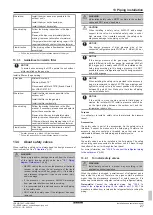
16 Configuration
Installation and operation manual
38
LREN8~12A7 + LRNUN5A7
CO
₂
ZEAS outdoor unit and capacity up unit
4P704141-1B – 2022.12
Conversion ratio for indoor units: refrigeration
Type
Conversion ratio (kg/kW)
Low temperature
Medium
temperature
Blower coil
0.059
Showcase
0.441
0.294
15.3
To charge refrigerant
1
Turn OFF the operation switch of the outdoor unit.
2
Turn ON the power supply of the outdoor unit and all indoor
units (blower coils, showcases).
3
Charge refrigerant from the service port SP7 in front of the stop
valve (i) on the refrigeration liquid side. Keep the stop valve
closed. See
"13.5.1 Checking refrigerant piping: Setup"
29].
4
When charging is finished, open all stop valves.
5
Attach the valve caps to the stop valves and service ports.
Pressure difference too low
If the pressure difference between the charging cylinder and
refrigerant piping is too low, you cannot charge anymore. Continue
as follows to decrease the pressure in the piping and to be able to
continue charging:
1
Open the gas stop valve (h).
2
Adjust the opening of the liquid stop valve (i).
3
Turn ON the operation switch of the outdoor unit. The pressure
in the refrigerant piping will drop, and charging can be
continued.
NOTICE
In case of long field piping length, the outdoor unit
automatically stops when charging refrigerant with the
liquid stop valve fully closed. Adjusting the liquid stop valve
avoids an unwanted stop.
4
When the refrigerant is charged, fully open all gas and liquid
stop valves.
WARNING
After charging refrigerant, keep the power supply and
operation switch of the outdoor unit ON to avoid a pressure
increase on the low pressure (suction piping) side and to
avoid pressure increase on the pressure side of the liquid
receiver.
INFORMATION
After charging, add the total amount of refrigerant to the
refrigerant charge label. See
38].
15.4
To fix the refrigerant charge label
1
Fill in the label as follows:
kg
RXXX
GWP: XXX
a
b
a
Total refrigerant charge
b
GWP value of the refrigerant
GWP = Global Warming Potential
2
Fix the label on the outdoor unit near the nameplate.
16
Configuration
DANGER: RISK OF ELECTROCUTION
INFORMATION
It is important that all information in this chapter is read
sequentially by the installer and that the system is
configured as applicable.
16.1
Making field settings
16.1.1
About making field settings
To configure the outdoor unit and capacity up unit, you must give
input to the main PCB (A1P) of the outdoor unit and capacity up unit.
This involves the following field setting components:
▪ Push buttons to give input to the PCB
▪ A 7-segment display to read feedback from the PCB
▪ DIP switches to set the target evaporating temperature for the
refrigeration side
16.1.2
To access the field setting components
You do not have to open the complete electrical component box to
access the field setting components.
1
Open the front panel (middle front panel in case of outdoor
unit). See
"12.2.1 To open the outdoor unit"
18].
2
Open the inspection hole cover (left), and turn OFF the
operation switch.
3
Open the inspection hole cover (right), and make the field
settings.
a
b
c2
c1
1 2 3 4
OFF
ON
DS1
d
d e
d e
e
1 2 3 4
OFF
ON
DS2
BS1 BS2 BS3
REMOTE
OFF ON
e1
e2
e3
a
Outdoor unit
b
Capacity up unit
c1
Inspection hole
c2
Inspection hole cover
d
Operation switch (S1S)
e
Field setting components
e1
7‑segment displays: ON (
) OFF (
) Flashing (
)
e2
Push buttons:
BS1: MODE: For changing the set mode
BS2: SET: For field setting
BS3: RETURN: For field setting
e3
DIP switches
4
After making the field settings, reattach the inspection hole
covers and the front plate.
NOTICE
Close the cover of the electrical component box before
turning ON the power.















































